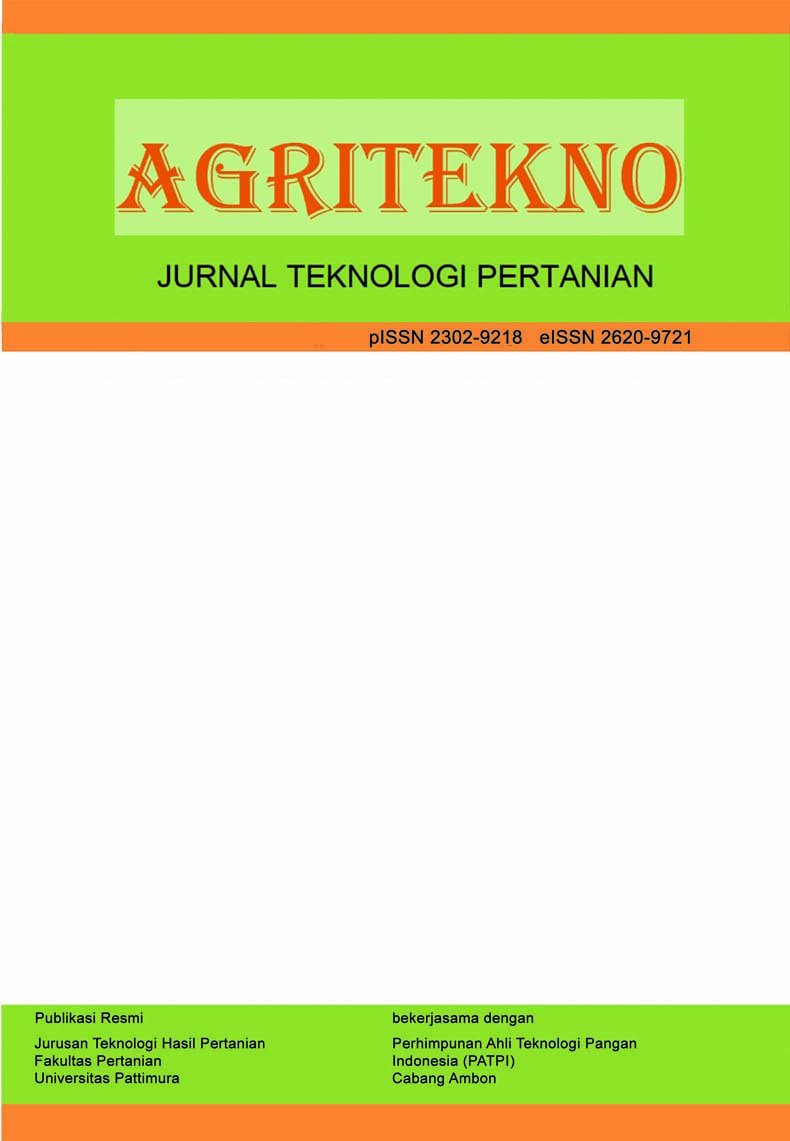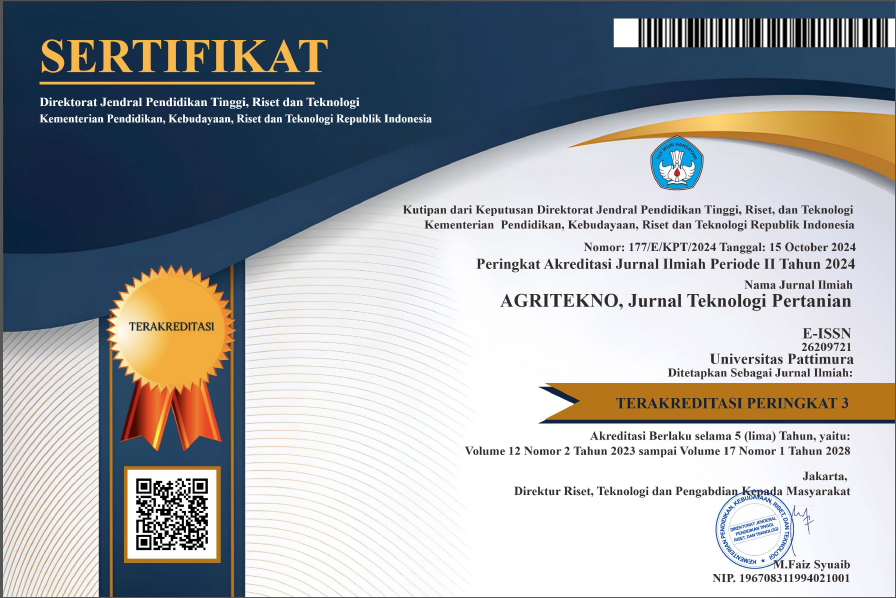Karakteristik Fisikokimia dan Sifat Fungsional Pati Alami Ubi Kayu Hasil Ekstraksi Secara Sederhana
Physicochemical Characteristics and Functional Properties of Native Cassava Starch Obtained Through Simple Extraction
Abstract
Starch production is one of the post-harvest handling methods for cassava, and the resulting native starch can serve as a basic ingredient in various food industries. Understanding the physicochemical and functional properties of native starch and starch modifications such as profiles, gelatinization, retrogradation of starch paste, and rheological features is necessary to determine the appropriate application of starch in different products. This study aimed to determine cassava starch's characteristics, focusing on its physicochemical and functional properties to provide value. Native starch produced from cassava variety Adira-4 tends to exhibit relatively high viscosity (9084 cP), low solubility (0.4%), fairly low swelling power (35.39%), and low clarity (49.5%). Its brightness level was 84.81%, which was lower than the quality standard set by the Standard Nasional Indonesia (SNI). It also possessed type A crystallinity with more compact properties, limiting its application due to its functional properties.
Downloads
References
Ariani, L. N., Estiasih, T., & Martati, E. (2017). Karakteristik sifat fisiko kimia ubi kayu berbasis kadar sianida. Jurnal Teknologi Pertanian, 18(2), 119–128.
Castanha, N., Matta Junior, M. D. da, & Augusto, P. E. D. (2017). Potato starch modification using the ozone technology. Food Hydrocolloids, 66, 343–356. https://doi.org/10.1016/j.foodhyd.2016.12.001
Castro, C. M., Ramírez-Wong, B., Contreras-Jiménez, B., Quintero-Ramos, A., Figueroa-Cárdenas, J., & Vázquez-Lara, F. (2022). Effect of extrusion on the crystallinity, viscosity, damage starch, and thermal properties of corn flour, masa, and tortilla. Applied Food Research, 2, 100198. https://doi.org/10.1016/j.afres.2022.100198
Cheetham, N. W. H., & Tao, L. (1998). Variation in crystalline type with amylose content in maize starch granules: An X-ray powder diffraction study. Carbohydrate Polymers, 36, 277–284. https://doi.org/10.1016/S0144-8617(98)00007-1
Chisenga, S. M., Workneh, T. S., Bultosa, G., & Laing, M. (2019). Characterization of physicochemical properties of starches from improved cassava varieties grown in Zambia. AIMS Agriculture and Food, 4(4), 939–966. https://doi.org/10.3934/agrfood.2019.4.939
Colussi, R., Lisie, S., El, M., Zanella, V., Bartz, J., Carlos, L., Zavareze, R., Renato, A., & Dias, G. (2015). Acetylation of rice starch in an aqueous medium for use in food. LWT - Food Science and Technology, 62(2), 1076–1082. https://doi.org/10.1016/j.lwt.2015.01.053
Cozzolino, D. (2016). The use of the rapid visco analyser (RVA) in breeding and selection of cereals. Journal of Cereal Science, 70, 282–290. https://doi.org/10.1016/j.jcs.2016.07.003
Fathoni, A., Hartati, N. S., Wahyuni, H. F., Rahman, N., Harmoko, R., & Perwitasari, U. (2020). Characterization of cassava starch and its potential for fermentable sugar production. IOP Conference Series: Earth and Environmental Science, 439(1). https://doi.org/10.1088/1755-1315/439/1/012024
Fonseca-florido, H. A., Hernández-ávila, J., Rodríguez-, A. I., Castro-rosas, J., & Acevedo-sandoval, O. A. (2017). Thermal, rheological and mechanical properties of normal corn and potato starch blends. International Journal of Food Properties, 20,3, 611–621. https://doi.org/10.1080/10942912.2016.1171779
Garces, V., García-Quintero, A., Lerma, T. A., Palencia, M., Combatt, E. M., & Arrieta, Á. A. (2021). Characterization of cassava starch and its structural changes resulting of thermal stress by functionally-enhanced derivative spectroscopy (FEDS). Polysaccharides, 2(4), 866–877. https://doi.org/10.3390/polysaccharides2040052
Gozé, P., Rhazi, L., Pauss, A., & Aussenac, T. (2016). Starch characterization after ozone treatment of wheat grains. Journal of Cereal Science, 70, 207–213. https://doi.org/10.1016/j.jcs.2016.06.007
Hamzah, Y., & Hill, S. E. (2010). Native Starches: Physicochemical, Thermal and Swelling Properties in Excess Water Department of Food Science, Faculty of Agrotechnology and Food Science. UMT Annual Seminar, 1-8.
Hasmadi, M., Harlina, L., Jau-Shya, L., Mansoor, A. H., Jahurul, M. H. A., & Zainol, M. K. (2021). Extraction and characterisation of cassava starch cultivated in different locations in Sabah, Malaysia. Food Research, 5(3), 44–52. https://doi.org/10.26656/fr.2017.5(3).550
Hoover, R. (2001). Composition, molecular structure, and physicochemical properties of tuber and root starches: A review. Carbohydrate Polymers, 45, 253–267. https://doi.org/10.1016/S0144-8617(00)00260-5
Indrianti, N., Nanang Surahman, D., & Kartika Indah Mayasti, N. (2015). The use of cassava flour from different harvest time with the addition of corn flour in making dried noodle. Pangan, 24 (1), 63-74
Katsumi, N., Okazaki, M., Yonebayashi, K., & Kawashima, F. (2015). New proposal for crystalline index of starch. Sago Palm, 22, 25–30.
Kim, H. Y., Park, S. S., & Lim, S. T. (2015). Preparation, characterization and utilization of starch nanoparticles. Colloids and Surfaces B: Biointerfaces, 126, 607–620. https://doi.org/10.1016/j.colsurfb.2014.11.011
Klein, B., Levien, N., Moomand, K., Zanella, V., Colussi, R., Zavareze, R., Renato, A., & Dias, G. (2014). Ozone oxidation of cassava starch in aqueous solution at different pH. Food Chemistry, 155, 167–173. https://doi.org/10.1016/j.foodchem.2014.01.058
Le Corre, D., & Angellier-Coussy, H. (2014). Preparation and application of starch nanoparticles for nanocomposites: A review. Reactive and Functional Polymers, 85, 97–120. https://doi.org/10.1016/j.reactfunctpolym.2014.09.020
Lian, X., Cheng, K., Wang, D., Zhu, W., & Wang, X. (2018). Analysis of crystals of retrograded starch with sharp X-ray diffraction peaks made by recrystallization of amylose and amylopectin. International Journal of Food Properties, 20(3), 3224–3236. https://doi.org/10.1080/10942912.2017.1362433
Luchese, C. L., Spada, J. C., & Tessaro, I. C. (2017). Industrial Crops & Products Starch content affects physicochemical properties of corn and cassava starch-based films. Industrial Crops & Products, 109(May), 619–626. https://doi.org/10.1016/j.indcrop.2017.09.020
Minakawa, A. F. K., & Faria-tischer, P. C. S. (2019). Simple ultrasound method to obtain starch micro- and nanoparticles from cassava, corn and yam starches. Food Chemistry, 283, 11–18. https://doi.org/10.1016/j.foodchem.2019.01.015
Monroy, Y., Rivero, S., & García, M. A. (2018). Ultrasonics - Sonochemistry Microstructural and techno-functional properties of cassava starch modified by ultrasound. Ultrasonics - Sonochemistry, 42, 795–804. https://doi.org/10.1016/j.ultsonch.2017.12.048
Muzaifa, M., Sulaiman, M. I., & Liyuza. (2014). Evaluasi sifat fisik pati ganyong (Canna edulis Kerr.) sebagai bahan baku pembuatan kwetiaw pada tingkat substitusi yang berbeda. Sagu, 13(2), 35–40.
Oladebeye, A. O., Oshodi, A. A., Amoo, I. A., & Karim, A. A. (2013). Functional, thermal and molecular behaviors of ozone-oxidized cocoyam and yam starches. Food Chemistry, 141(2), 1416–1423. https://doi.org/10.1016/j.foodchem.2013.04.080
Perez, L. A. B., & Agama-Acevedo, E. (2017). Starch. In Starch-Based Materials in Food Packaging. Elsevier Inc. https://doi.org/10.1016/B978-0-12-809439-6.00001-7
Petit, T., & Puskar, L. (2018). Diamond & Related Materials FTIR spectroscopy of nanodiamonds: Methods and interpretation. Diamond & Related Materials Journal, 89(8), 52–66. https://doi.org/10.1016/j.diamond.2018.08.005
Prabasini, H., Ishartani, D., Rahadian, D. (2013). Kajian sifat kimia dan fisik tepung labu kuning (Cucurbita moschata) dengan perlakuan blanching dan perendaman dalam natrium metabisulfit (Na2S2O5). Jurnal Teknosains Pangan, 2(2), 93-102.
Rahman, N., Fitriani, H., & Sri Hartati. (2020). Morphological variation and beta carotene contents of several clones of ubi kuning cassava genotype derived from irradiated shoot in vitro. Jurnal Ilmu Dasar, 21(2), 73-80
Rina Heldiyanti. (2020). Postharvest deterioration of breeding cassava during the storage. Jurnal Agrotek Tropika, 8(2), 225-234.
Sun, Q., Fan, H., & Xiong, L. (2014). Preparation and characterization of starch nanoparticles through ultrasonic-assisted oxidation methods. Carbohydrate Polymers, 106, 359–364.
Tester, R. F., Karkalas, J., & Qi, X. (2004). Starch — Composition, Fine Structure and Architecture. 39, 151–165. https://doi.org/10.1016/j.jcs.2003.12.001
Torres, M. D., Moreira, R., Chenlo, F., Morel, M. H., & Barron, C. (2014). Physicochemical and structural properties of starch isolated from fresh and dried chestnuts and chestnut flour. Food Technology and Biotechnology, 52(1), 135–139.
Vanier, N. L., Lisie, S., El, M., Renato, A., Dias, G., & Zavareze, R. (2017). Molecular structure, functionality and applications of oxidized starches: A review. Food Chemistry, 221, 1546–1559. https://doi.org/10.1016/j.foodchem.2016.10.138
Wahyuningsih, S., & Sutrisno. (2019). Pertumbuhan dan produktivitas beberapa varietas ubi kayu dengan tingkat pupuk yang berbeda di lahan tegakan jati muda. Buletin Palawija, 17(1), 40–45.
Waterschoot, J., Gomand, S. V, & Delcour, J. A. (2016). Impact of swelling power and granule size on pasting of blends of potato, waxy rice and maize starches. Food Hydrocolloids, 52, 69–77. https://doi.org/10.1016/j.foodhyd.2015.06.012
Zhu, F. (2015). Composite ion, structure, physicochemical properties, and modifications of cassava starch. Carbohydrate Polymers, 122, 456–480. https://doi.org/10.1016/j.carbpol.2014.10.063
Copyright (c) 2024 The Author(s)

This work is licensed under a Creative Commons Attribution-ShareAlike 4.0 International License.
Authors who publish with this journal agree to the following terms:
- Authors retain copyright and grant the journal the right of first publication with the work simultaneously licensed under a Creative Commons Attribution License that allows others to share the work with an acknowledgement of the work's authorship and initial publication in this journal.
- Authors are able to enter into separate, additional contractual arrangements for the non-exclusive distribution of the journal's published version of the work (e.g., post it to an institutional repository or publish it in a book), with an acknowledgement of its initial publication in this journal.
- Authors are permitted and encouraged to post their work online (e.g., in institutional repositories or on their website) prior to and during the submission process, as it can lead to productive exchanges, as well as earlier and greater citation of published work (See The Effect of Open Access).









